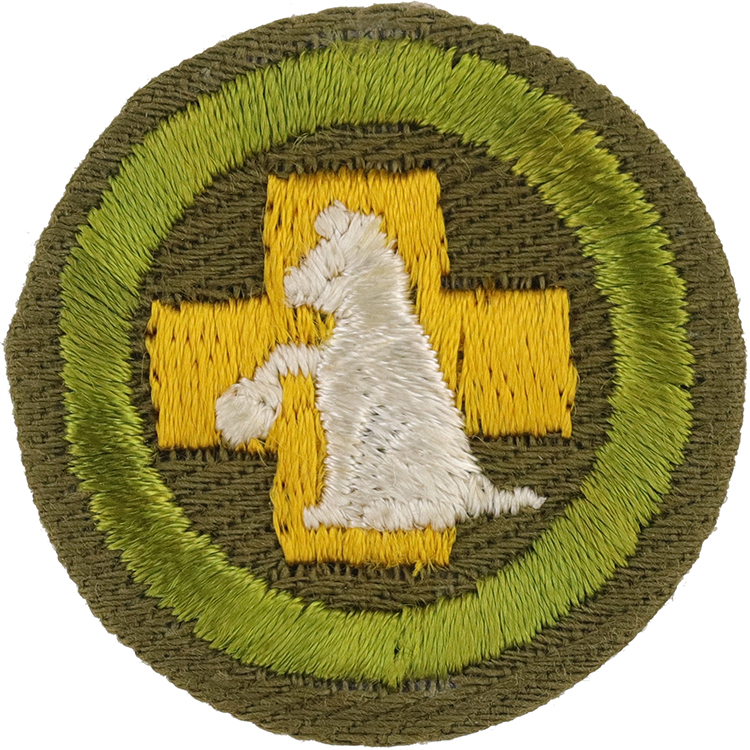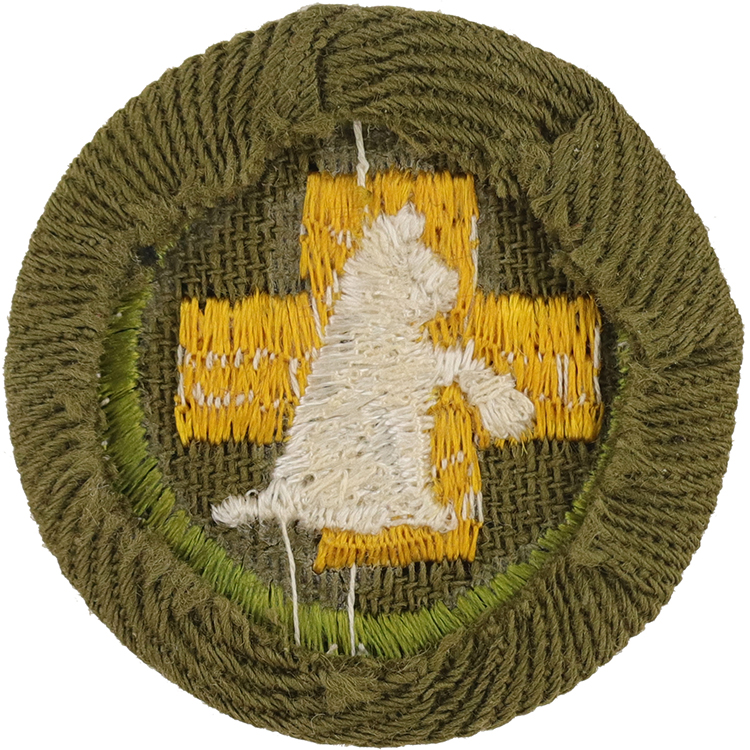
Fig. 1: FirAni-E2-Front
- Cloth: Khaki right twill
- Embroidery: Cotton lock stitch

Fig. 2: FirAni-E2-Reverse
- Back: Plain NO imprint with starch

Fig. 3: FirAni-E2-mve1-front
- Minor variation: Dog differences

Fig. 4: FirAni-E2-mve1-reverse
- Back: Plain NO imprint with starch
Item Name: First Aid to Animals 1947 - 1960
Item ID: FirAni-E2
Collector Rating: 1
Requirements May 1940 until June 1948
1. Prepare and explain a schedule for the proper management of at least one farm animal, covering a period of one month, to show what must be done to prevent illness, blemishes, defects, and disease, arising from improper or unsanitary surroundings.
2. Be able to recognize the symptoms and explain the proper treatment for the following: Horses: (a) lameness, (b) exhaustion from overheating, (c) distemper. Cows: (d) Milk fever. Sheep: (e) Foot and mouth disease, (f) anthrax. Hogs: (g) cholera. Dogs: (h) distemper, (I) rabies.
3. Explain fully what he would do for the animal in the following emergencies; (a) wire cuts, (b) choking, (c) colic, (d) bloat, (e) when a horse falls in stall or on the highway, (f) cruelty or neglect of domestic animals.
4. Demonstrate on an animal how to treat: (a) a broken bone, (b) a sprain, (c) serious bleeding, (d) an open sore.
5. Present evidence that he has: (a) assisted in the care of an injured or sick animal for a period of at least four days; or (b) cooperated with humane society or local officials in behalf of animals; or (c) cooperated with local officials in prevention of hog cholera or other infectious diseases to which farm animals are subject.
OR
(As alternative to foregoing set of five requirements)
Comply with 4-H Club or Home Project requirements in First Aid to Animals as follows:
1. Carry out all projects as required by leaders.
2. Do all work as required for a season or year.
3. Keep an accurate record of each project in First Aid work and report results.
4. Demonstrate First Aid to Animals, as required by his leaders.
Requirements June 1948 until January 1957.
1. Prepare and explain a schedule for the proper management of at least one farm animal, covering a period of one month, to show what must be done to prevent illness, blemishes, defects, and disease, arising from improper or unsanitary surroundings.
2. Be able to recognize the symptoms and explain the proper treatment for the following: Horses: (a) lameness, (b) exhaustion from overheating, (c) distemper. Cows: (d) Milk fever. Sheep: (e) Foot and mouth disease, (f) anthrax. Hogs: (g) cholera. Dogs: (h) distemper, (I) rabies.
3. Explain fully what he would do for the animal in the following emergencies; (a) wire cuts, (b) choking, (c) colic, (d) bloat, (e) when a horse falls in stall or on the highway, (f) cruelty or neglect of domestic animals.
4. Demonstrate on an animal how to treat: (a) a broken bone, (b) a sprain, (c) serious bleeding, (d) an open sore.
5. Present evidence that he has: (a) assisted in the care of an injured or sick animal for a period of at least four days; or (b) cooperated with humane society or local officials in behalf of animals; or (c) cooperated with local officials in prevention of hog cholera or other infectious diseases to which farm animals are subject.
OR
Comply with 4-H Club or Home Project Requirements.
Requirements January 1957 until September 1963
1. Prepare and explain a schedule for the proper management of at least one farm animal, covering a period of one month, to show what must be done to prevent illness, blemishes, defects, and disease, arising from improper or unsanitary surroundings.
2. Be able to recognize the symptoms and explain the proper treatment for the following: Horses: (a) lameness, (b) exhaustion from overheating, (c) distemper. Cows: (d) Milk fever. Sheep: (e) Foot and mouth disease, (f) anthrax. Hogs: (g) cholera. Dogs: (h) distemper, (I) rabies.
3. Explain fully what he would do for the animal in the following emergencies; (a) wire cuts, (b) choking, (c) colic, (d) bloat, (e) when a horse falls in stall or on the highway, (f) cruelty or neglect of domestic animals.
4. Demonstrate on an animal how to treat: (a) a broken bone, (b) a sprain, (c) serious bleeding, (d) an open sore.
5. Present evidence that he has: (a) assisted in the care of an injured or sick animal for a period of at least four days; or (b) cooperated with humane society or local officials in behalf of animals; or (c) cooperated with local officials in prevention of hog cholera or other infectious diseases to which farm animals are subject.
* As a 4-H'er, complete a club project in this subject. Or as an FFA member, meet these or equivalent requirements through the FFA supervised farming program.


